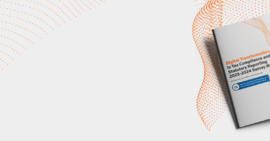The current COVID-19 pandemic crisis has upended the general way we do business, creating many challenges for how leaders of professional service organizations — like law firms, corporate law and tax departments, and tax & accounting firms — can provide their teams with their basic needs for predictability, control, and human connection.
Without these needs, we’re in a crisis situation that generates enormous stress while reducing our teams’ sense of well-being.
In the first part of this article, I discussed how leaders can help their teams get a stronger sense of predictability and control by being aware of their own behavior. Now, I want to discuss how leaders can help re-build a sense of connection among their team members.
Connection
More and more emerging research underlines the importance of relationships. They build psychological resilience; they strengthen our immune system (a nice feature when trying to fight off a virus); and they increase both personal happiness and work satisfaction. Good relationships have even been shown to prolong life. Indeed, the mandate to practice “social distancing” ironically imposes barriers to connection at a time when it would do us the most good.
What can you as a leader do? Convene video-conferences with your team members frequently. We often assume that the main benefit of videoconferencing is the efficiency of disseminating information or discussing issues, but they also serve a very important social purpose. Convene them more often than you think is logically necessary.
Also, encourage your team members to keep in touch with each other, especially via visual media like Skype or Zoom or even Instagram and other static social media. And encourage them to check in with friends, loved ones, and isolated or vulnerable members of their social circle. Isolation can produce sadness and lower immune response. (And according to Harvard Business Review, the legal profession is already the loneliest profession.)
You can join Dr. Larry Richard in an upcoming remote event, Shadows on the Shore: Managing Employee Mental Health & Morale, at 12 pm, EST on April 9
Another aspect of social connection is the need we all have to be part of something larger than ourselves. In a crisis like this, there’s an opportunity to tap into our innate need to feel connected to all others. One potential silver lining to the crisis is that because it’s a threat to the entire planet, people are more inclined to unite around the sentiment that “we’re all in this together.” In fact, it’s dawning on many of us that we are truly linked to all others in very concrete ways. When I seclude myself in my home, I’m not just avoiding my own exposure to the virus — I’m also actively taking a step to protect others in my community from possible infection. Ironically, isolation is itself a community-minded act.
In Summary
Here, in one spot, are the actionable suggestions I’ve mentioned which derive from the principles I’ve outlined. I’ve also added some additional Do’s and Don’ts that derive from the same principles:
- Set up a regular time to communicate with your people, to inform them, to keep them updated about developments and about steps that you’re taking. It’s reassuring to know that there’s a particular time every day or every week when they’ll hear from you.
- In a time of uncertainty, communication is reassuring, lowers anxiety, and builds community.
- Communicate by Skype or Zoom if you can. Video is the most emotionally connected medium, and in a time of crisis, you need to foster connection. If video is impractical, do your updates and check-ins via telephone conference call. Only as a last resort use email — it’s less personal, less connected, and invites one-way communication and less give-and-take.
- Encourage your people to reach out to loved ones, friends, clients, and others in their communities just to check in and see how people are doing. When people work remotely, it can be isolating. Reaching out is good for your team members and good for those they call.
- This is not the time for a command-and-control leadership style. Everyone knows that you don’t know how this will turn out. Instead, adopt a two-way communication style, seek the input of your people. Care for them, and check in with them. See how everyone’s doing. Build community. Be as authentic and compassionate as you can. Despite how uncomfortable you or many of your team members find it, vulnerability in a time of crisis builds trust, bonds, and connection.
- Communicate to everyone — whether your team is lawyers or tax professionals, you also have business services professionals, operations and administrative staff, and support staff. Don’t use different messaging for each group — everyone needs to hear the same message. (If you need to discuss financial or other sensitive issues, you can always convene a separate partners-only call.)
- Give people an opportunity to express their feelings and report the ways that they’re coping.
- Direct peoples’ attention towards those things that remain operational and that remain stable — the things they can count on. In a time of change and uncertainty, it’s reassuring to remind people about things that aren’t
- Create routines, rituals, and things that people can look forward to on a regular basis. The familiar is always calming and reassuring.
- Above all, exercise your empathy muscle. Put yourself in the shoes of the other person. Ask yourself what kind of experience they may be having. Ask yourself how your communication may be perceived — are they likely to receive it the way you meant it?
- Slow down — pay attention to your demeanor while talking to others. Pay attention not only to the content of your messaging but to the manner in which you deliver it. Especially in a time of crisis, people are more sensitized to hearing tone and nuance. If you sound stressed in the way you communicate, for example, then you’ll arouse stress in your listener. Deliver your messages in calm, steady, and reassuring ways.
- Take time out during the day to manage your own stress. Take long, slow deep breaths. Exhale longer than you inhale. Or, do five minutes of progressive muscle relaxation — starting with your feet, tighten the muscles to a count of three, then slowly relax the muscles as you count backwards from three. Then, work your way through the muscle groups of your body until you reach the top of your scalp. Or consider mindfulness meditation. (There are easy to find book and app suggestions on mindfulness meditation.) Remember, you’ll be most effective as a leader when you “put your own oxygen mask on first.”
The bottom line is that your actions as a leader matter more now than ever. If you take those actions in a way that restores some sense of predictability, gives choices to your team members, and supports maintaining connections, you will lower everyone’s stress, foster greater well-being, and maintain productivity and performance despite this terrible crisis.


